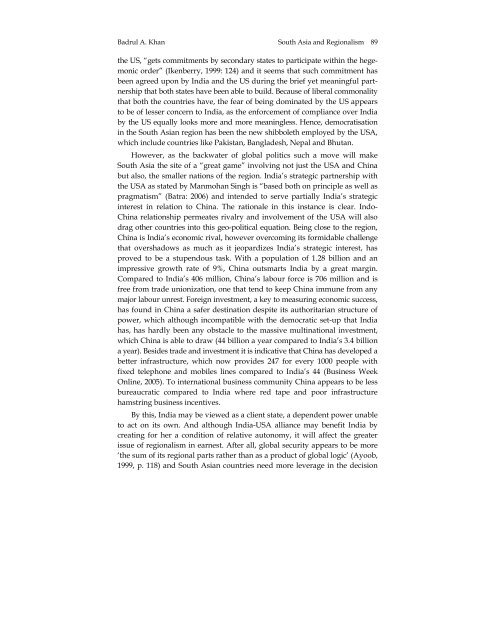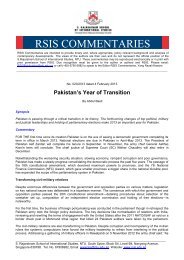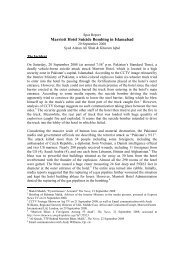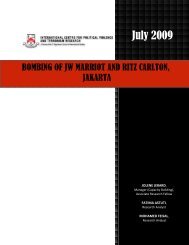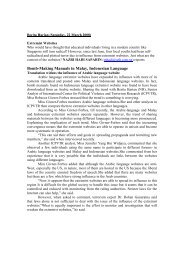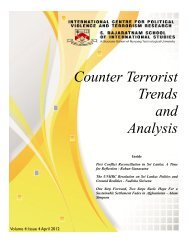Peace and Security Review, Vol.1 No. 2 - International Centre for ...
Peace and Security Review, Vol.1 No. 2 - International Centre for ...
Peace and Security Review, Vol.1 No. 2 - International Centre for ...
Create successful ePaper yourself
Turn your PDF publications into a flip-book with our unique Google optimized e-Paper software.
Badrul A. Khan South Asia <strong>and</strong> Regionalism 89<br />
the US, “gets commitments by secondary states to participate within the hegemonic<br />
order” (Ikenberry, 1999: 124) <strong>and</strong> it seems that such commitment has<br />
been agreed upon by India <strong>and</strong> the US during the brief yet meaningful partnership<br />
that both states have been able to build. Because of liberal commonality<br />
that both the countries have, the fear of being dominated by the US appears<br />
to be of lesser concern to India, as the en<strong>for</strong>cement of compliance over India<br />
by the US equally looks more <strong>and</strong> more meaningless. Hence, democratisation<br />
in the South Asian region has been the new shibboleth employed by the USA,<br />
which include countries like Pakistan, Bangladesh, Nepal <strong>and</strong> Bhutan.<br />
However, as the backwater of global politics such a move will make<br />
South Asia the site of a “great game” involving not just the USA <strong>and</strong> China<br />
but also, the smaller nations of the region. India’s strategic partnership with<br />
the USA as stated by Manmohan Singh is “based both on principle as well as<br />
pragmatism” (Batra: 2006) <strong>and</strong> intended to serve partially India’s strategic<br />
interest in relation to China. The rationale in this instance is clear. Indo-<br />
China relationship permeates rivalry <strong>and</strong> involvement of the USA will also<br />
drag other countries into this geo-political equation. Being close to the region,<br />
China is India’s economic rival, however overcoming its <strong>for</strong>midable challenge<br />
that overshadows as much as it jeopardizes India’s strategic interest, has<br />
proved to be a stupendous task. With a population of 1.28 billion <strong>and</strong> an<br />
impressive growth rate of 9%, China outsmarts India by a great margin.<br />
Compared to India’s 406 million, China’s labour <strong>for</strong>ce is 706 million <strong>and</strong> is<br />
free from trade unionization, one that tend to keep China immune from any<br />
major labour unrest. Foreign investment, a key to measuring economic success,<br />
has found in China a safer destination despite its authoritarian structure of<br />
power, which although incompatible with the democratic set-up that India<br />
has, has hardly been any obstacle to the massive multinational investment,<br />
which China is able to draw (44 billion a year compared to India’s 3.4 billion<br />
a year). Besides trade <strong>and</strong> investment it is indicative that China has developed a<br />
better infrastructure, which now provides 247 <strong>for</strong> every 1000 people with<br />
fixed telephone <strong>and</strong> mobiles lines compared to India’s 44 (Business Week<br />
Online, 2005). To international business community China appears to be less<br />
bureaucratic compared to India where red tape <strong>and</strong> poor infrastructure<br />
hamstring business incentives.<br />
By this, India may be viewed as a client state, a dependent power unable<br />
to act on its own. And although India-USA alliance may benefit India by<br />
creating <strong>for</strong> her a condition of relative autonomy, it will affect the greater<br />
issue of regionalism in earnest. After all, global security appears to be more<br />
‘the sum of its regional parts rather than as a product of global logic’ (Ayoob,<br />
1999, p. 118) <strong>and</strong> South Asian countries need more leverage in the decision<br />
<strong>Vol.1</strong>, <strong>No</strong>.2 2008 pp.77-93


